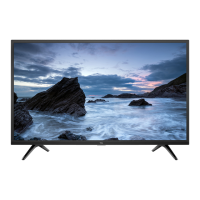
Do you have a question about the TCL D3000 Series and is the answer not in the manual?
| Display Technology | LED |
|---|---|
| Refresh Rate | 60Hz |
| Smart TV | Yes |
| Operating System | Android |
| Wi-Fi | Yes |
Read all instructions before operating the set and keep them for future use.
Avoid serious personal injury or death by taking precautions when placing the television set.
Do not block ventilation, push objects into slots, or touch the screen with fingers.
Unplug the set if unused for long periods or if the power cord/plug is damaged.
Protect power and signal cables from damage, trampling, and moisture.
Place the TV in a well-ventilated area, avoid damp, heat, and dusty environments.
Dust the screen and cabinet with a soft cloth; avoid water or chemical cleaners.
Requires two people; ensure the wall supports the weight and use suitable screws.
Use TV buttons for control when the remote is unavailable, covering various functions.
Details USB, HDMI, Antenna/Cable, SPDIF, and AV sockets for connecting external devices.
Explains the function of each button on the remote control for navigating menus and settings.
Steps for inserting batteries, connecting power cable, and turning on the TV set.
Instructions for putting the TV into standby mode or unplugging it from the mains.
How to access and navigate the main menu, select options, and adjust settings.
How to select the desired input source for the TV, such as TV, AV, or HDMI.
Adjust picture settings like mode, brightness, contrast, sharpness, color, and aspect ratio.
Configure sound settings including mode, treble, bass, balance, and surround sound.
Details sound modes like Standard, Movie, Music, Sports, and User-defined settings.
Selects the sound type for SPDIF output, Auto or PCM, based on program format.
Allows adjustment of audio settings using the equalizer for personalized sound.
Covers auto tuning, manual tuning, and fine-tuning channels for optimal reception.
Manage channel locking, set passwords, and lock individual channels for restricted access.
Access settings for language, LED status, sleep timer, auto standby, and HDMI link.
Select the desired language for the TV's menus and on-screen display.
Control the LED indicator status when the TV is in standby mode (On/Off).
Set a timer for the TV to automatically switch to standby mode after a set period.
Enable automatic standby mode after a period of inactivity to save power.
Manage CEC features like Auto PowerOn and Auto Standby for connected HDMI devices.
Update the TV's software by inserting a USB stick with the new version.
Restore TV menus and settings to their original factory default configuration.
View pictures, listen to music, watch videos, and read text files from a USB drive.
Display pictures from a USB device, with slideshow functionality available.
Play audio files from a USB drive, with an Audio Only mode for listening.
Watch video files from a USB drive with playback and console options.
Read text files stored on a USB drive directly on the TV screen.
Solutions for network linking, video playback, sound issues, and device recognition.
Steps to resolve issues with linking the TV to the network and internet connection.
Diagnose and resolve choppy video playback due to USB, network bandwidth, or file format.
Tips for when two mobile hard disks are connected, recommending one at a time.
Troubleshoot no sound on USB video playback due to unsupported audio formats.
Address issues where certain video files, especially from cameras, may not play.
Troubleshoot issues where external devices like webcams or game handles are not recognized.
Diagnose and resolve common TV problems like no picture, no sound, color issues, or remote control failure.
Checks for fuse, power, outlet, and signal source to resolve no picture or sound.
Troubleshoot no color issues by adjusting color system, saturation, or trying new channels.
Resolve remote control issues by checking batteries and their installation.
Fix no picture issues by adjusting brightness and contrast, or checking broadcasting.
Resolve no sound issues by checking volume, mute, and sound system settings.
Minimize picture ripples caused by local interference like cars or lamps by adjusting antenna.
Improve weak signal reception by adjusting antenna position and fine-tuning channels.
Address picture flutter or streaks caused by interference from ignition systems or appliances.
Resolve ghosting effects caused by signal reflection by adjusting antenna direction.
Identify and remove sources of radio frequency interference causing ripples or streaks.
Details terms of use, warranties, limitations, and third-party service disclaimers for the device.